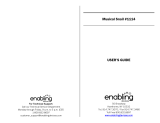
2
©
2017 DJI All Rights Reserved.
EN
Disclaimer and Warning
Thank you for purchasing the DJI™ Snail Propulsion System
(hereinafter referred to as “product”). Read this disclaimer
carefully before using this product. By using this product, you
hereby agree to this disclaimer and signify that you have read
it fully. Please install and use this product in strict accordance
with the User Manual. SZ DJI TECHNOLOGY CO., LTD. and
its affiliated companies assume no liability for damage(s) or
injuries incurred directly or indirectly from using, installing or
retting this product improperly, including but not limited to
using non-designated accessories.
DJI is a trademark of SZ DJI TECHNOLOGY CO., LTD. (abbreviated
as “DJI”) and its aliated companies. Names of products, brands,
etc., appearing in this manual are trademarks or registered
trademarks of their respective owner companies. This product and
manual are copyrighted by DJI with all rights reserved. No part of
this Product or manual shall be reproduced in any form without
the prior written consent or authorization of DJI.
This disclaimer is produced in various languages. In the event of
divergence among dierent versions, the Chinese version shall
prevail when the Product in question is purchased in China,
and English version shall prevail when the Product in question is
purchased in any other region.
Legend
Important Hints and Tips Reference
Warning
When powered on, the motors and propellers will rotate very
quickly and can cause serious damage or injuries. Always be
vigilant and make safety your top priority.
1. Always attempt to fly your aircraft in areas free of people,
animals, power lines, and other obstacles.
2. DO NOT approach or touch the motors or propellers when the
unit is powered on.
3. Ensure that there are no open circuits or short circuits when
soldering the ESC cables.
4. Before takeoff, ensure that the propellers and motors are
installed correctly.
5. Ensure that all parts of the aircraft are in good condition. DO
NOT y with worn or damaged parts.


















